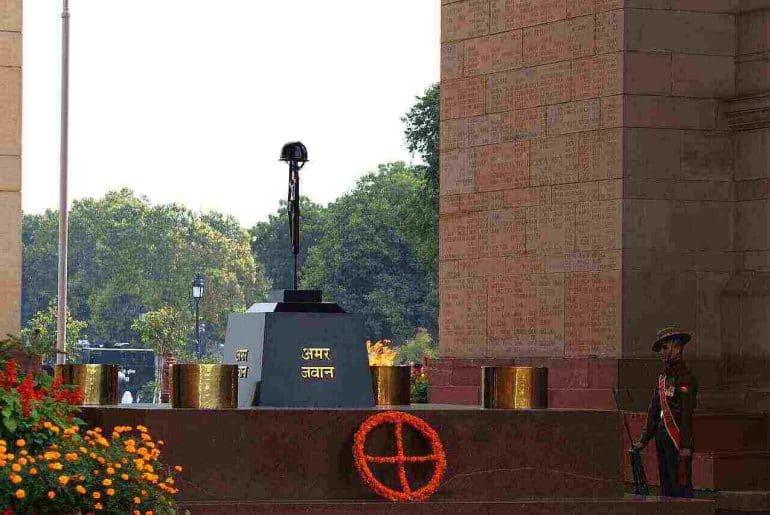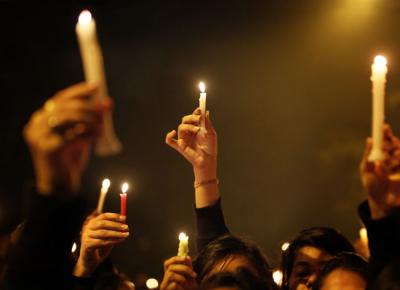The Amar Jawan Jyoti has been merged with the flame at the National War Memorial on a bright Friday afternoon but was this step the “need of the hour” or simply unsolicited? Read ahead to find out more.
On 21 January 2022, the Amar Jawan Jyoti at the India Gate was merged with the eternal flame at the National War Memorial in New Delhi. The ceremony for the same took place on 21st January afternoon. A part of the Amar Jawan Jyoti flame was taken and merged with the flame at the National War Memorial at India Gate. Chief of Integrated Defence Staff Air Marshal B R Krishna presided over this ceremony. However, the merger soon became a page of the controversial political book. This step was welcomed but not without a good share of criticism from some.
The Amar Jawan Jyoti under the India Gate was established back in 1972 by then Prime Minister Indira Gandhi. It was constructed to pay homage to the lives that we lost during the Indo-Pakistan war of 1971 which resulted in the creation of Bangladesh. It was inaugurated on 26 January 1972 after India came out victorious in the war in December 1971. The eternal flame at the Amar Jawan Jyoti was an evocative symbol that paid tribute to the nation’s fallen soldiers in the line of duty. This “memorable” piece of the nation’s history consists of a base on which there is a cenotaph. The words “Amar Jawan” are scripted in gold on all four sides of the cenotaph and the latter has a reversed rifle with a war helmet on top of it. It also has four urns (burners) which were lit on important national days, else only one of them was kept alive around the year and was never allowed to be extinguished. The same was kept alive eternally with the help of piped natural gas (PNG).
This eternal flame was placed under the India Gate or the All India War Memorial as previously known. It was constructed by the British in 1931 to pay a tribute to the 90,000 Indian soldiers of the British Indian Army that were lost in multiple wars till then. Hence, the flame was placed under it since the memorial was in the remembrance of the fallen Indian soldiers.

The primary reason stated by the government officials to take this step, as reported by the Indian Express, is that the India Gate is a symbol of our “colonial past” and does not even carry a mention of the soldiers lost during the 1971 war. Moreover, the flame would not be extinguished but just moved to be merged with the one in the National War Memorial. The National War Memorial was established by our Prime Minister Narendra Modi back in 2019 which also houses an eternal flame. As asserted by the defense officials, it seemed only right to keep a single flame instead of two when all the officials and foreign dignitaries paid their homage at the new establishment. This merger might be one of the unnecessary necessities of the country that was addressed. Although the step is subjected to a political row on the pretense of respective political ideology and was both welcomed and criticized, was it really imperative to shake the history of this country?
Another reason to carry forward this merger was that the people of the country are bonded to the Amar Jawan Jyoti emotionally. They did not feel the same sentiment for the National war Memorial and the latter did not catch the public eye to the extent anticipated. Now, not only the government is zealous for the new memorial’s promotion but this step can also be seen as a part of one of the government’s current endeavors, the central vista project.
The central vista project or this merger is undertaken for the creation of the believed “Indian property”. This is the justification given to the restructuring of the heart of the National Capital. Now it may sound patriotic and the chauvinistic feelings might propagate but where should the line be drawn to demarcate the symbolic shift of power and the nation’s prestige? The Amar Jawan Jyoti is a part of that history because of which the present we are living in flourished. The undermining of the same in the name of the colonial past or British property would not lead to the creation of the believed missing link. That lost link is between Indian sentiments and prestige and the historic sacrifices that were made in the colonial past. Keeping up two flames might look unnecessary so one of them was decided to be put to sleep but how long are we going to put the history to sleep in the name of patriotism? Every part of colonial history, every remnant from the British period holds a quintessential value and an emotional aspect. The Jyoti was lit when people were reeling from the loss. To say that it has to be put off for paying a tribute to not only them but all is quite materialistic. Other measures could have turned up if creative efforts were on the table which would have ensured a certain place of the new memorial but jeopardizing a piece of history to garner attention is not quite acceptable. Nevertheless, as much as this step was criticized, it was whole-heartedly welcomed by some. Everything is done in the name of our country and the feelings of patriotism continue to perpetuate. Yet, the tri-colored flag should be the sole agenda instead of the orange one. Doing this, would ensure the growth of the nationalist zeal for eternity and bring sheer joy to the countrymen and not only the ones in power.
Read Also: Cries of Kashmir: 200 Plus Days
Featured Image Credits: Wikimedia Commons
Ankita Baidya



 fought against the rapists for her life. “The crowd was very peaceful and calm. More than a sense of revenge, there seemed to be a solemn atmosphere. Despite the fact that there was a group of people yelling ‘Hang the rapists!’ at the top of their lungs, most present realised that the point of meeting at Jantar Mantar was to pay tribute to the girl who was raped as well as all the other women who have suffered due to shameless, savage minds,” said Ankita, a student of Lady Shri Ram College.
As students continue to organise street plays and people come together to light candles in memory of the 23 year old medical student, the direction of these protests and marches seem to be aimed at a complete overhaul of the existing safety regulations and policies. This might just be the start of a new revolution, spearheaded by the dynamic and powerful youth of a nation infested with outdated laws and run by ageing leaders well beyond their time.]]>
fought against the rapists for her life. “The crowd was very peaceful and calm. More than a sense of revenge, there seemed to be a solemn atmosphere. Despite the fact that there was a group of people yelling ‘Hang the rapists!’ at the top of their lungs, most present realised that the point of meeting at Jantar Mantar was to pay tribute to the girl who was raped as well as all the other women who have suffered due to shameless, savage minds,” said Ankita, a student of Lady Shri Ram College.
As students continue to organise street plays and people come together to light candles in memory of the 23 year old medical student, the direction of these protests and marches seem to be aimed at a complete overhaul of the existing safety regulations and policies. This might just be the start of a new revolution, spearheaded by the dynamic and powerful youth of a nation infested with outdated laws and run by ageing leaders well beyond their time.]]> 


 In what is being seen as the next biggest uprising India saw since Anna Hazare’s India Against Corruption, the protest march that commenced today on India Gate has surely got the parliament at its toes.
In what is being seen as the next biggest uprising India saw since Anna Hazare’s India Against Corruption, the protest march that commenced today on India Gate has surely got the parliament at its toes. fullest potential”, said Nikita, a protestor. Gopal Krishna Gandhi, former Governor of Bengal showed up to voice his support.
fullest potential”, said Nikita, a protestor. Gopal Krishna Gandhi, former Governor of Bengal showed up to voice his support. rape victim could be felt. There was unity in the crowd which prevented the crowd from turning into a violent mob. The only violence that existed was towards the inefficiency of the police and law makers.
rape victim could be felt. There was unity in the crowd which prevented the crowd from turning into a violent mob. The only violence that existed was towards the inefficiency of the police and law makers.